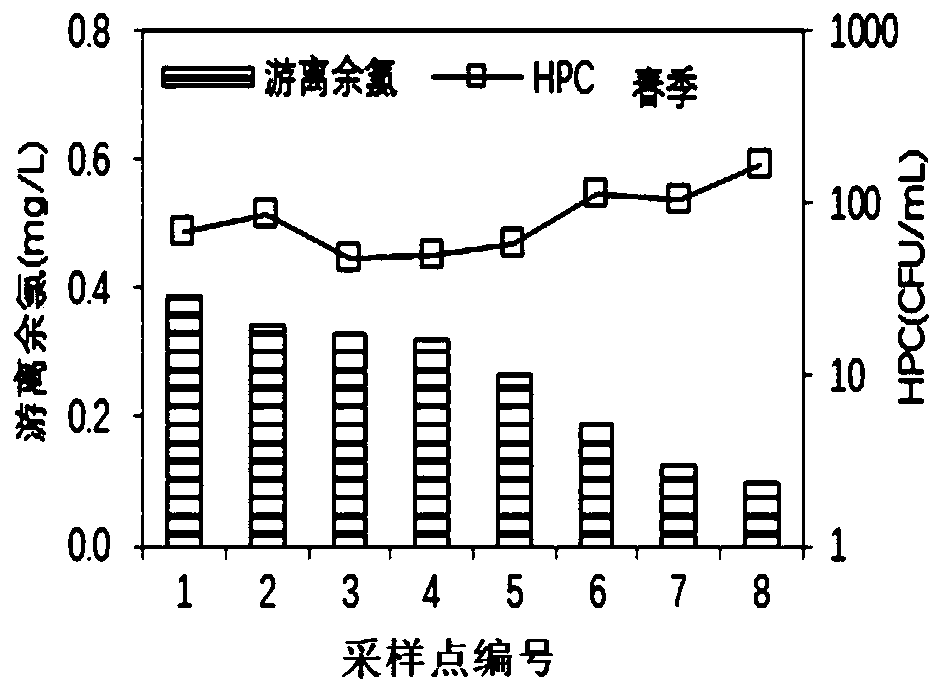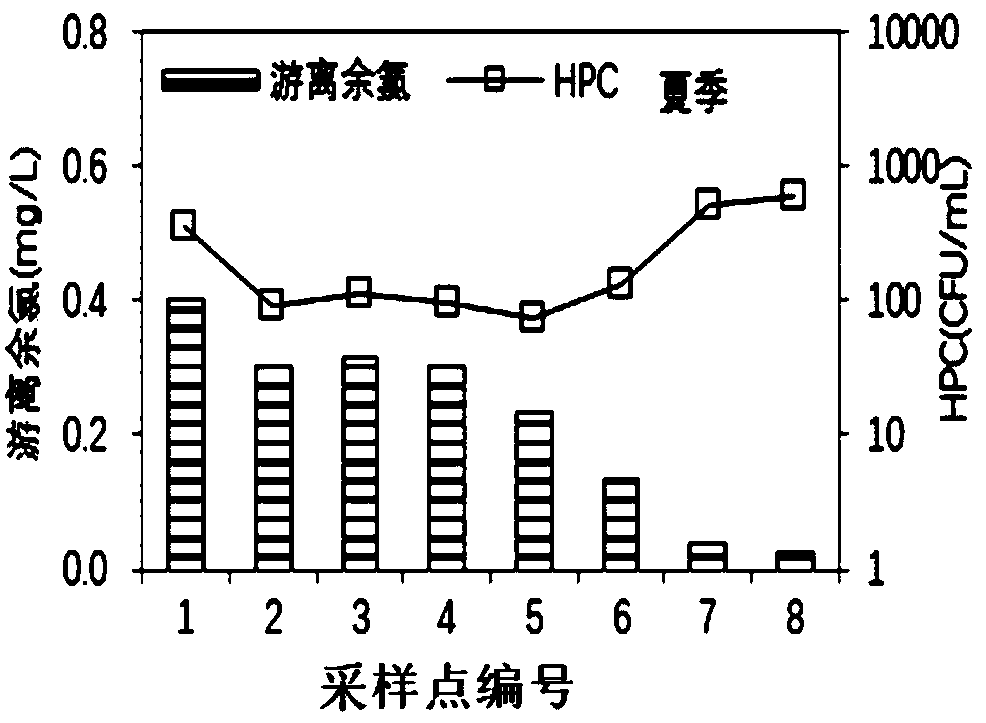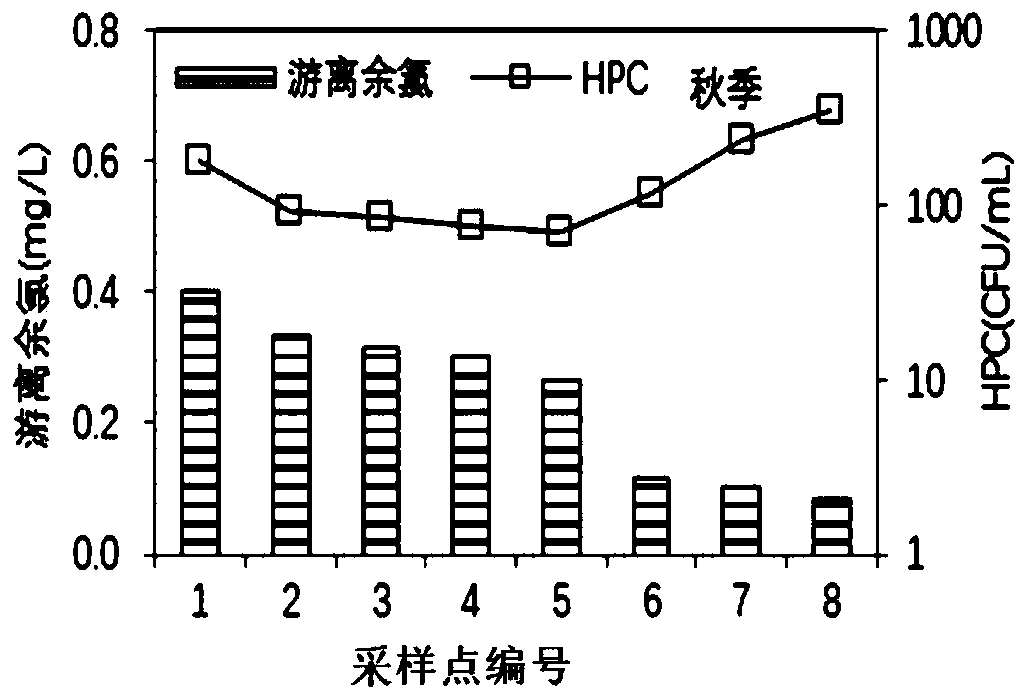Chlorine supplementing method for guaranteeing water quality biological stability of long-distance water delivery pipe network
A bio-stability, water-conveying pipe technology, applied in chemical instruments and methods, oxidized water/sewage treatment, water/sludge/sewage treatment, etc., can solve the problems of high heterotrophic colony count and low residual chlorine concentration
- Summary
- Abstract
- Description
- Claims
- Application Information
AI Technical Summary
Problems solved by technology
Method used
Image
Examples
specific Embodiment approach 1
[0235] Specific implementation mode 1: In this implementation mode, the method of supplementing chlorine to ensure the water quality and biological stability of the long-distance water delivery pipe network is carried out according to the following steps:
[0236] 1. Select the target water delivery network in the area, analyze the correlation between residual chlorine in the water and HPC, and determine the minimum concentration limit of residual chlorine in the water delivery network to ensure the biological stability of its water quality;
[0237] 2. Establish the residual chlorine decay model and the DBPs generation and consumption model for the water outlet of the clean water tank of the water intake plant, and take samples at the sampling port of the main water distribution pipe to detect the water quality of the feed water to test and optimize the water quality model;
[0238] 3. Taking the filtered water of the water plant as the object, measure the ammonia nitrogen con...
specific Embodiment approach 2
[0241] Specific embodiment two: the difference between this embodiment and specific embodiment one is that the method for setting up residual chlorine decay model described in step two is as follows:
[0242] Measure 50mL of the water out of the clean water tank of the water intake plant and add it to a 50mL stoppered colorimetric tube to obtain multiple samples. Treat different samples to measure the residual chlorine concentration. , the water sample has existed for tt water age,
[0243] The following four assumptions are put forward in establishing the residual chlorine decay model:
[0244] (1) The decay reaction of residual chlorine and the formation of DBPs during actual disinfection are first-order reactions based on the concentration of residual chlorine;
[0245] (2) There is a fixed ratio s(DBPs) between the production of various DBPs and the consumption of residual chlorine;
[0246] (3) The consumption reactions of various DBPs are first-order reactions based on...
specific Embodiment approach 3
[0257] Specific embodiment three: the difference between this embodiment and specific embodiment one or two is that the method for establishing the DBPs generation and consumption model described in step two is as follows:
[0258] Take 50mL of the water from the clear water tank of the water intake plant and add it to a 50mL stoppered colorimetric tube to obtain multiple samples. Add ascorbic acid to the bottle to quench the reaction of DBPs, and then measure the concentration of various DBPs to obtain the concentration of DBPs in water samples of different water ages, and use tt to represent the hydraulic retention time of the clear water tank, because when water is taken from the outlet of the clear water tank, the water sample already exists tt water age;
[0259] The following four assumptions are made in building the model:
[0260] (1) The decay reaction of residual chlorine and the formation of DBPs during actual disinfection are first-order reactions based on the con...
PUM
 Login to View More
Login to View More Abstract
Description
Claims
Application Information
 Login to View More
Login to View More - R&D
- Intellectual Property
- Life Sciences
- Materials
- Tech Scout
- Unparalleled Data Quality
- Higher Quality Content
- 60% Fewer Hallucinations
Browse by: Latest US Patents, China's latest patents, Technical Efficacy Thesaurus, Application Domain, Technology Topic, Popular Technical Reports.
© 2025 PatSnap. All rights reserved.Legal|Privacy policy|Modern Slavery Act Transparency Statement|Sitemap|About US| Contact US: help@patsnap.com



